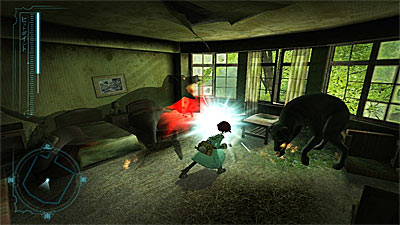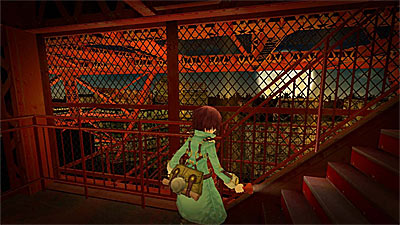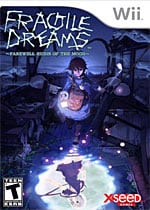It’s long been debated whether or not games can be art, but I will tell you right now, Fragile Dreams offers an experience that should clear up any doubt on the matter. Developer Tri-Crescendo takes players on a powerful journey through a post-apocalyptic world that will tug at your heart at every turn. The real question here, however, is: can art be a game?

You take on the role of Seto, and your journey begins with you burying the old man who has, up until this point, been caring for you in this desolate world you call home. You’re on a quest to find other survivors, and your travels through this lonely land will be filled with both discovery and sadness.
Though the art style of Fragile Dreams: Farewell Ruins of the Moon is unmistakably Japanese, the experience is far removed from your typical JRPG. As a matter of fact, the game isn’t really an RPG when you get right down to it, but we’ll get to that in just a moment.
The focus of Fragile Dreams is on its prose, and to that end, it is – and I say this without any hesitation – true poetry. The dialogue is flawless, the story progression is almost perfectly paced, and the crux of the game’s expression is: humanity – our flaws, our triumphs, our fears, and our love. You will feel something when you play Fragile Dreams…
To be sure, I was completely swept up by the experience, and on more than one occasion, I was driven to tears. As Seto wanders these abandoned ruins, he’ll come upon keepsakes that store the memories of their former owners. The back-story is directly linked to these mementos discovered throughout the game, and it’s a mesmerizing strand of the journey that drives you onward.
For all intents and purposes, Fragile Dreams is an adventure game with light combat tossed into the mix. Seto will gain experience and level up by defeating enemies, but increasing your health and attack power is pretty much the extent of the game’s RPG components. Thankfully, most of your time will be spent investigating environments, exploring the world, and experiencing the wonders of the story.

You will have to do some fighting, and unfortunately, it’s the game’s one true Achilles’ heel. Before I get too deeply into that, however, let me first explain the controls so that you’ll fully understand why combat was such a thorn in my side while playing this game.
Fragile Dreams calls for use of both the Wii Remote and Nunchuk. You move Seto with the analog stick, and camera control is handled by pointing the Wii Remote. If you try to move the Wii Remote too quickly to the edge of the screen in order to change your view, the camera will lock. So, you’re forced to move quite slowly, and as you’ve probably already surmised, this will leave you wide open to attacks when engaging enemies. It can also be a bit frustrating when simply trying to look around for clues and items, though it’s easier to forgive when you can take your time.
With the camera being what it is, combat becomes an awkward dance of stepping on your own toes, so to speak. I eventually found various tricks that got me through the game’s requisite encounters, but it was ultimately the equivalent of using duct tape to hold together Michelangelo’s David. When push came to shove, I ran past every enemy I could, and to the game’s credit, I was still always leveled up sufficiently to take on unavoidable fights.

I’m not sure a lock-on feature would have helped, either, as the combat itself just isn’t that interesting. It’s mostly a matter of tapping the A button, but there are a handful of ranged weapons that make fun use of the Wii Remote’s pointer functionality.
I can’t deny the combat in Fragile Dreams was a substantial sore spot for me, and there were other elements of the gameplay that also fell a bit flat. A stealth mini-game, hide-and-go-seek, fetch quests, and insanely long, drawn-out treks down boring corridors – none these things were all that exciting, though they each proved to be a competent means to the story’s end. In spite of my disappointment with the camera and its effects on combat, I absolutely fell head over heels for the story and overall experience.

The game takes a few cues from the Resident Evil series with its inventory design, and though there can be some tedium and busy work involved in the process of moving items around, it’s still a very finely tuned interface I enjoyed quite a bit. Weapons break and new ones must be found or purchased (from a wandering vendor in a chicken suit), and with limited space in your on-hand inventory, you’ll occasionally be faced with having to forfeit items in favor of new discoveries.
Visually, Fragile Dreams puts pretty much all of its eggs in the right basket. The character models and overall pervading mood of the game have been given plenty of loving attention, though technical details in the environment aren’t terribly impressive. The character expressions are thoroughly moving, but getting caught in tight quarters can yield some unsightly results – jittering animations and such. Additionally, there were occasional bouts of slowdown, both in battle and out.
Little touches, however, such as how maps are made to look as though they were hand drawn by Seto, go a long way toward drawing you into the story. As a counterpart to what the game is trying to say as a form of expression, Fragile Dreams hits one out of the park on Wii.
Without a doubt, one of the strongest elements of the game’s production is its sound design. The music is always fitting and masterfully mixed. More importantly, the developers make incredible use of sound as a gameplay mechanic, with the speaker on the Wii Remote cuing you to enemy locations, as well as clues about your current objective. Rather than incorporating use of the Wii Remote’s microphone as a novelty, the sound design delivers a three-dimensional experience that feels relevant.
The music is no slouch, either, though themes don’t always segue smoothly when entering or exiting battle. There are some hauntingly beautiful song performances, however, and if you’re taken with the game, you’ll likely want to consider picking up the optional soundtrack as well.
The English voice acting is decent, though I personally recommend players choose the Japanese vocal option before setting out on the adventure. Fragile Dreams is built around Japanese culture and norms, and the elegance of the performances by the Japanese voice actors picks up the slack where words fail.
Fragile Dreams: Farewell Ruins of the Moon is a title I wholeheartedly recommend to every Wii owner. It’s also a game that is, unfortunately, held back from true greatness by its own gameplay. The combat is sure to frustrate even the most forgiving of gamers, as you’ll be doing more fighting with the controls than the actual enemies in the game. That being said, Fragile Dreams is worth fighting for. Push past its flaws, and you’ll be rewarded with a beauty that is priceless. I won’t dare claim the game to be a masterpiece, but it is still very much a work of art.
RATING OUT OF 5 RATING DESCRIPTION 4.0 Graphics
There are technical elements (especially during daytime segments) that look less than great. Where it counts the most, however, Fragile Dreams looks beautiful. Lots of great, little touches convey a world full of loneliness and promise. 3.4 Control
The controls are actually almost great. Use of the Wii Remote to control Seto’s flashlights should be satisfying, but the camera is just too temperamental. There are other elements of the control scheme, however, that are inspired, and if nothing else, there’s enough here to allow players to hobble through the worst parts of the gameplay. 4.4 Music / Sound FX / Voice Acting
Some of the song performances, alone, are almost worth the price of admission, and the use of the Wii Remote’s speaker as a gameplay device works like no other game on Wii. It can be jarring, though, to hear themes abruptly begin and end when engaging enemies. 4.4
Play Value
Fragile Dreams has a quality rare in any medium, let alone gaming. Come to the experience with an open heart, and you’ll walk away glowing. It’s brimming with love and affection, as well as sadness and despair. You will, however, need to carry the baggage of its gameplay flaws for much of the journey.
3.8 Overall Rating – Good
Not an average. See Rating legend above for a final score breakdown.
Game Features:
